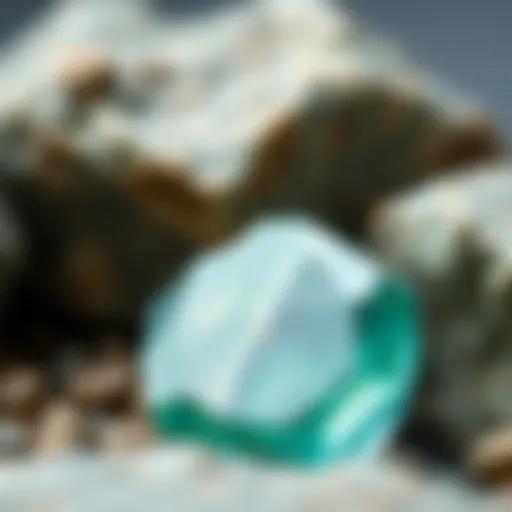Exploring the Natural Emerald: A Comprehensive Guide
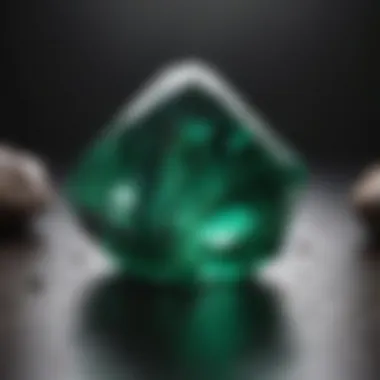

Intro
Natural emeralds have captured the imagination of collectors and enthusiasts for centuries. Renowned for their lush green hues and captivating clarity, these gemstones are more than just decorative pieces; they are steeped in history and brimming with geological tales. The journey of understanding emeralds begins not just with their beauty, but with the stories they tell about the Earth itself.
In this guide, we will embark on a thorough exploration of emeralds, blending scientific insights with cultural significance. Our aim is to provide a holistic view, from the very formation of these splendid gems to the nuances of purchasing, caring for, and valuing them. By the time you reach the end, you’ll likely appreciate why these gems are considered treasures in the world of geology and jewelry alike.
Understanding Natural Emeralds
Emeralds have captured human fascination for centuries, standing out not just for their stunning green hue but also for their rich history and significance across cultures. This section aims to provide a solid foundation for understanding natural emeralds, focusing on their definition, formation, and worldwide locations, which will be further discussed throughout the article. Grasping these core concepts is crucial for anyone looking to delve deeper into the world of gemstones, whether you’re embarking on a collection journey or simply looking to appreciate these gems from an informed perspective.
Defining Natural Emeralds
When we discuss natural emeralds, we refer specifically to the gems that form organically in the earth’s crust. Unlike their synthetic counterparts, these genuine stones undergo a complex geological process that involves specific heat and pressure conditions over millions of years. The defining aspects of a natural emerald include its rich color, exceptional clarity, and the presence of inclusions, known as the "jardin," which can actually enhance its character and value.
It’s worth noting that not all green gemstones qualify as emeralds. The strict definition hinges on their beryl mineral composition and the trace elements—particularly chromium and vanadium—that contribute to their vibrant green hue.
The Geological Origins
Emeralds don’t just appear out of thin air; understanding their geological origins helps us appreciate their rarity and worth.
Formation Conditions
Natural emeralds are formed in metamorphic rocks under very specific conditions. Ideal environments typically involve a combination of high pressure and temperature, along with the right chemical elements. What makes this formation particularly interesting is the role of the mineral-rich fluids that seep through the rocks, bringing in vital nutrients. This process can take millions of years, contributing to the stone’s uniqueness and natural beauty. One of the most contributing factors to the beauty of natural emeralds is how their formation involves a variety of geological events, leading to different color variations. These factors make emeralds not only stunning but also quite rare in nature, making them an appealing choice for collectors.
Emerald Deposits Around the World
Emeralds discover interest not only due to their formation but also due to where they’re found. The world is graced with several notable emerald deposits, with some of the most famous ones located in Colombia, Brazil, and Zambia. Each region produces emeralds with distinct characteristics, often dictated by the specific geological conditions of that area. Colombian emeralds, for instance, are renowned for their deep, vivid green shade, often accompanied by fewer inclusions than their Zambian counterparts. Interestingly, while emeralds from Brazil may exhibit a bluish tint due to different trace elements, Zambian emeralds are known for their striking saturation. This diversity in geographical origins contributes to the wide range of choices available to collectors, highlighting the unique qualities of each stone depending on its provenance.
Emeralds, with their natural allure and rich geological backstory, are much more than mere decorative pieces; they tell stories of the earth’s processes over millions of years. By understanding how they are defined and formed, you will be better equipped to appreciate not just their aesthetic value, but also their significance in the broader context of geology and culture.
Physical Characteristics
Understanding the physical characteristics of natural emeralds is crucial for any gem aficionado. These traits not only define the beauty and quality of the stone but also significantly influence its value and appeal in the market. When collectors or enthusiasts delve into emeralds, the main factors at play are color, clarity, hardness, and the presence of unique inclusions. Each of these elements provides insight into the stone’s geological origins and its historical significance.
Color and Clarity
Understanding Color Variations
Color is perhaps the most striking feature of an emerald. These gemstones can display a wide range of green shades, from pale green to deep, rich hues. The best emeralds typically possess a vibrant green color with a vivid saturation. What makes color variations particularly fascinating in emeralds is the way different geographical locations influence the hue. For instance, emeralds from Colombia often have a bluish undertone, while Zambian emeralds can show a more yellowish tint. This variability allows collectors to appreciate the subtle nuances of origin.
- Vividness: A vivid color is always preferred; it generally enhances the stone's desirability.
- Hue Ranges: The presence of secondary colors like blue or yellow can change the overall impression of the stone.
The unique feature of this characteristic is its ability to provide both aesthetic appeal and potential investment value. Collectors often seek vivid green stones as they are seen as crown jewels among emeralds.
Impact of Clarity on Value
Clarity plays a vital role in determining an emerald's value. Unlike diamonds, emeralds often have inclusions that are not seen as flaws but rather as unique identities. These inclusions can range from minor to significant and are commonly referred to as "jardin," a French word for garden, which reflects the intertwined patterns found within the stone. Generally, the clearer an emerald, the higher its value; however, many collectors appreciate the evidence of natural growth within emeralds as part of their charm.
- Clarity Grading: Clarity is often judged on a scale that categorizes stones as included, slightly included, vs. eye-clean, with clear emeralds being rare and more valuable.
- Natural Features: Inclusions can tell a story about the stone’s journey through time, adding character.
The significant aspect of clarity is how it intertwines with value—while a pristine emerald garners a higher price, some collectors deliberately opt for stones that reveal this natural history.
Hardness and Durability
Mohs Scale Rating
The hardness of an emerald is rated on the Mohs scale, where it scores between 7.5 and 8. This rating signifies that while emeralds are resilient, they require handling with care. Their position in the Mohs scale indicates that, while they are tougher than many gemstones, they are still more prone to scratching compared to harder stones like sapphires or diamonds. This quality impacts not only wearability but also the type of settings chosen for jewelry.
- Resilience: Their hardness allows them to withstand everyday wear but careful treatment is advisable to avoid chips.
- Gemstone Care: Emeralds typically require protective settings, especially in rings, to minimize direct contact and potential damage.
The unique aspect here is balancing beauty with practicality; collectors often seek out exquisite cut stones while being fully aware of their durability constraints.
Common Treatments for Additional Hardness
Emeralds frequently undergo treatments aimed at enhancing clarity and durability. One common method is oiling, which involves infusing the gemstone with oil to enhance its clarity and improve the depth of color. While this is a widely accepted practice, it can affect the stone's long-term durability.
- Natural vs. Treated: Collectors should know whether they’re acquiring a natural gem or a treated one; treatments can impact resale value.
- Maintenance Considerations: Oiled emeralds should be cleaned carefully and may require re-oiling over time.
This added layer of treatment signifies an area of potential concern for collectors. While enhanced gems can hold visual appeal, understanding the implications of treatments is crucial for informed purchasing decisions.
Unique Inclusions and Their Significance
Types of Inclusions
Emeralds often display unique inclusions, which can range from liquid-filled cavities to other minerals trapped during formation. These inclusions may offer a fascinating narrative on how each individual stone came to be. Not only do they contribute to the beauty and individuality of the emerald, but certain types can also enhance the charm for collectors.
- Feather: A common inclusion that looks like a feather.
- Two-Phase: Air and liquid inclusions can create stunning effects if viewed properly.
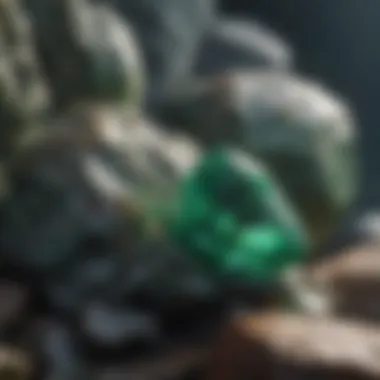

The key characteristic of inclusions is their diversity; rather than seeing them merely as flaws, many gem enthusiasts view them as part of the gemstone’s story and charm.
How Inclusions Affect Perceived Value
The relationship between inclusions and perceived value is enlightening. Well-placed inclusions can add character, while unsightly ones can substantially diminish a stone's desirability. For collectors, understanding this relationship is paramount. They often seek out stones with attractive inclusions, while potential buyers might fret over those perceived as significant flaws.
- Market Trends: Inclusions that enhance a gem's character may align with shifting market preferences.
- Collectibility Factor: Stones with rare or visually appealing inclusions might fetch a premium over standard emeralds.
Inclusions offer not just an insight into geological history but also a chance to make informed choices based on their appeal in the superior market. Whether seen as detractors or enhancements, they certainly hold sway over how these gems are valued.
Cultural and Historical Significance
Emeralds have captured human imaginations for centuries, their lush green hues and rarity making them a gemstone of choice among various cultures. This section dives into how emeralds have shaped cultures across time and space and why they are more than just pretty gemstones. From ancient beliefs to modern-day symbolism, understanding the cultural and historical significance of emeralds allows collectors to appreciate the nuances beyond their physical characteristics.
Emeralds in Ancient Civilizations
Egyptian Beliefs
In ancient Egypt, emeralds were not just beautifu gems; they were believed to be manifestations of the goddess of love, fertility, and rebirth, Isis. The Egyptians considered emeralds to bring protection and empowerment, which played a significant role in their rituals and customs. Scarab amulets carved from emeralds were often placed in tombs as a means of providing the deceased with guidance in the afterlife. This highlights the key characteristic of spiritual power associated with emeralds in those times. For collectors, understanding this historical context enriches the value of owning an emerald. Knowing that the stone has ties to divine beliefs adds a layer of reverence that simply admiring its beauty does not.
On top of that, ancient texts reveal that Cleopatra wore emeralds as symbols of her royalty and divine lineage. This unique feature elevates emeralds far beyond mere adornment; they are tied to narratives of power and identity. While this leads to their beneficial appeal for modern collectors, it also presents a challenge—the immense competition from replicas and synthetics that can undermine their authenticity.
Mayan Culture
The Mayans shared a profound appreciation for emeralds, viewing them as sacred stones that represented fertility and prosperity. They often associated them with the gods of rain, considering emeralds to be gifts that brought about agricultural abundance. This further illustrates the significance of emeralds as markers not just of status, but of sustenance and survival in ancient societies. In context, the Mayan reverence for emeralds highlights their essential role in cultural identity, providing beautiful insights for collectors and enthusiasts interested in historical artifacts.
Unique to the Mayan culture is the notion that emeralds served as conduits between the living and the spirit world. This enriches the narrative around the gemstones, providing depth about their use in ceremonies and trading practices. However, this also introduces a complexity in valuation—an authentic Mayan emerald might not just be valued solely based on its quality but also how it connects to historical ontext, which can lead to misunderstandings among less informed buyers.
Emeralds in Modern Society
Famous Emeralds in History
Fast forward to contemporary times, and emeralds still steal the spotlight. Some of the most renowned emeralds, like the Duke of Devonshire Emerald and The Patricia Emerald, have fascinating histories that enhance their allure. They are often sold in auctions, commanding exorbitant prices that reflect not merely their physical attributes but also the rich stories embedded in their existence. This aspect, tied directly to their cultural heritage, makes these emeralds highly sought after by collectors who appreciate not just the gem itself but everything it represents.
The legendary tales surrounding these famous emeralds serve as a bridge connecting modern enthusiasts to the past. Collectors can find immense value in the stories of these historical gems, and they're often viewed as investment opportunities not solely for their intrinsic worth but for their narratives.
Symbolism in Literature and Art
Emeralds haven’t just been trapped in the earth; they’ve permeated the realms of literature and art as well. Many authors—and even contemporary pop culture figures—have referenced emeralds in works as symbols of opulence, mystery, and healing. In literature, emeralds symbolize rebirth and transformation, often linked to characters overcoming significant challenges. In art, they’re used to evoke feelings of peace and tranquility. These associations enhance the beneficial nature of emeralds as collectibles, offering more than just a visual appeal; they have stories that resonate with significant meaning.
A unique feature in this context is the perception of emeralds as stones that not only adorn but also tell stories. In modern art, emerald-green hues are often indicative of balance and harmony, which resonates well with themes of mental and emotional wellness. For the discerning collector, understanding these layers of symbolism can provide a lucrative foundation for building a well-rounded collection or even sharing these insights with fellow enthusiasts.
All these aspects clearly demonstrate that emeralds hold tremendous value beyond aesthetics; they carry history, culture, and narratives that enrich the world’s tapestry.
By appreciating the cultural and historical significance of emeralds, collectors can possess not just gemstones but pieces of history woven into the fabric of human civilization.
Synthetic vs. Natural Emeralds
When diving into the world of emeralds, one can't overlook an important distinction between synthetic and natural varieties. This topic is pivotal because understanding the differences not only enriches your knowledge but can also impact purchasing decisions, value assessment, and overall appreciation of these stunning gemstones. The market is flooded with various options, and being able to identify authentic natural emeralds from their synthetic counterparts is crucial for collectors and enthusiasts alike. Misunderstanding these differences could lead to dissatisfaction or financial pitfalls.
Defining Synthetic Emeralds
Synthetic emeralds are lab-created gemstones that replicate the chemical composition and physical properties of natural emeralds. Unlike their natural counterparts, which form over millions of years in specific geological conditions, synthetic emeralds can be produced in weeks or even days using methods like the flux-growth or hydrothermal processes. While they can mimic the richness of color and clarity found in natural stones, they lack the uniqueness that comes from centuries of geological formation. This distinction makes them an intriguing yet controversial choice in the gemstone community.
Distinguishing Factors
Visual Differences
Visual differences between natural and synthetic emeralds can be subtle yet significant. Natural emeralds often display unique characteristics called inclusions, which tell a story about their journey through time. These inclusions might include gases, minerals, or other elements trapped within the stone during its formation. Synthetic emeralds, on the other hand, usually exhibit fewer or different types of inclusions. This lack of natural “flaws” can make synthetic stones appear overly perfect, raising eyebrows among discerning collectors and gemologists.
"To the untrained eye, the sparkle of a synthetic emerald might seem just as alluring as a natural one, yet the character found in natural stones often proves to be invaluable."
In terms of clarity, natural emeralds usually present a richer, more nuanced depth that synthetic stones can struggle to replicate. While visual differences are not always glaringly obvious, a trained eye can discern these subtleties with practice. Thus knowing how to spot these differences can offer astute buyers a better insight into what they're acquiring, enhancing both the appreciation and valuation of their collection.
Testing Methods
When it comes to determining whether an emerald is synthetic or natural, robust testing methods are crucial. One widely utilized approach is spectroscopy, which analyzes the light absorption properties of the stone. Spectroscopic analysis can reveal telltale signs of creation, as synthetic emeralds often have distinct absorption patterns compared to their natural counterparts.
Another often effective method involves using a loupe or microscope to examine inclusions. Trained gemologists can identify specific markers unique to synthetic emeralds, such as gas bubbles or curved growth lines—features typically absent in natural specimens.
These testing methods are beneficial not just for verification purposes, but also for valuation assessments. Collectors can confidently invest in pieces when they possess a clear understanding of what they are buying. Knowing how to discern between these two types of emeralds will equip enthusiasts with the tools necessary to make informed decisions in their collecting journey.
Purchasing Advice for Collectors
When diving into the world of emeralds, especially for collectors, having a solid understanding of how to purchase these precious gemstones is crucial. Emeralds stand apart not just for their rich colors but also for their history and value. This section provides essential tips that can help collectors make informed choices, ensuring both satisfaction and investment security.
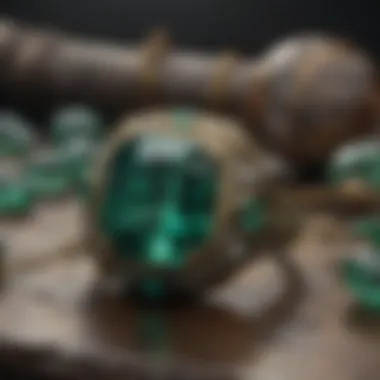

Identifying Quality
What to Look for in a Gemstone
When hunting for the perfect emerald, the first thing to hone in on is the four C's: color, clarity, cut, and carat weight. Among these, color probably takes center stage, as the richest shades often command the highest prices. The ideal emerald presents a vivid green hue, ideally without the muddiness that can occur with inferior stones.
Clarity is the next big player – while emeralds often contain inclusions, known as "jardin" in French, a high-quality specimen will have only minor, barely noticeable flaws. The cut of the gem impacts how well it reflects light; an expertly cut emerald will dazzle, while a poorly cut one may appear dull. Carat weight usually correlates with size and, indirectly, its value. Collectors should be wary of larger stones with poor color or clarity, as they may not be worth the investment. Think of it this way: a slightly smaller but high-quality emerald often far exceeds the appeal of a larger, lackluster stone.
Some collectors, too, might consider the origin of the emerald. Those from Colombia, for instance, are frequently regarded as the finest. So paying special attention to the source is a worthwhile avenue to explore.
Questions to Ask Sellers
Lining up the right questions can be the difference between a smart buy and a regrettable impulse. When faced with a lovely emerald, the first thing to nail down is whether the seller provides a certificate of authenticity. This document often assures that you are purchasing a natural stone and not a synthetic alternative.
It’s wise to inquire about any treatments the gemstone may have undergone. Many emeralds are oiled to enhance their clarity and color. The level and type of treatment can significantly affect its value, so it’s a vital question to ask.
Additionally, asking about return policies is equally important. A reputable seller will allow you some time to examine the stone after purchase, just in case something doesn’t sit right. Collectors shouldn’t shy away from requesting previous sales records or clientele references. A seller's track record is often the best predictor of future transactions.
Choosing Reputable Sources
As the adage goes, "Don’t put all your eggs in one basket." When it comes to sourcing emeralds, collectors face a vast array of options. That's where knowing reputable suppliers comes into play. A collector must do their homework to find trustworthy sellers, both online and in the physical marketplace.
Understanding Certifications
Understanding certifications is paramount. Places like the Gemological Institute of America (GIA) are gold standard in providing certifications that help affirm a stone’s quality and authenticity. Having a certified emerald can provide peace of mind, ensuring that it has been thoroughly evaluated by a professional expert.
A reputable certificate will detail the stone’s unique attributes, including color zoning, clarity grade, and any treatments it has received. This can help collectors safeguard against potential misrepresentation. A well-certificated emerald is not just a piece of jewelry; it’s an investment in history and beauty.
Online vs. In-Store Purchases
Navigating the waters of online versus in-store purchases can feel like a tightrope walk for many collectors. Online retailers often cater to a global audience, which means greater selection and often better pricing. But there's a catch: without seeing the emerald in person, buyers run the risk of receiving a stone that looks different from what they expected.
In-store purchases, on the other hand, afford the opportunity to see the gem under various lighting conditions and better analyze its quality. However, the selection might be more limited and prices could be steeper due to overhead costs.
One common compromise now is to combine both approaches. First, explore online options to broaden your understanding of availability and price ranges. Then, visit local jewelers to see if any stones match your earlier findings. Ultimately, each avenue has its own set of advantages and pitfalls, so weighing these before making a decision is entirely recommended.
Care and Maintenance of Emeralds
Emeralds, with their stunning green hue and rich history, deserve special care to maintain their beauty and integrity. Understanding the proper care and maintenance routines is crucial for any emerald owner, as neglect can lead to dullness or even irreparable damage. This section will provide detailed insights into keeping your emeralds in top condition, ensuring they remain as captivating as the day you acquired them.
Cleaning Techniques
Emeralds may be one of nature's marvels, but they require careful handling when it comes to cleaning. Using the wrong products or methods can easily cause harm to these precious stones.
Safe Cleaning Products
When cleaning emeralds, it’s vital to choose safe cleaning products that won't compromise their surface or color. Many traditional cleaners can have harsh chemicals that are detrimental.
Look for gentle, pH-balanced soaps or mild detergent. An excellent option is a solution of warm water with a few drops of dish soap. These products are favored because they effectively remove dirt without being abrasive.
One unique feature of safe cleaning products is their ability to clean emeralds without the risk of leaving behind harmful residues that might dull the stone’s brilliance. However, it's good to keep in mind that avoiding acidic or ammonia-based cleaners is essential – although they might clean other materials effectively, they can wreak havoc on emeralds.
Frequency of Cleaning
The frequency of cleaning your emeralds directly correlates with how often you wear them. If you're wearing emerald jewelry daily, consider giving it a light clean every week. This not only helps to remove everyday grime but also allows for early detection of any issues.
On the other hand, if your emeralds are part of a collection and remain stored most of the time, cleaning them every few months is usually sufficient. However, pay attention to your pieces: if you notice the emeralds look dull, it might indicate a deeper clean is needed.
A key characteristic of cleaning frequency is maintaining a balance. Too frequent cleaning can lead to unnecessary wear and tear, while inadequate cleaning can allow dirt to accumulate, potentially damaging the stone over time.
Storage Recommendations
Storing emeralds requires just as much care as cleaning them. The way they are stored can significantly affect their longevity and overall appearance.
Best Practices for Storage
To preserve their beauty, the best practices for storage involve keeping emeralds in protective cases. A soft cloth bag or lined jewelry box can safeguard your stones from scratches. When storing multiple pieces, make sure they don’t touch each other – separation is the name of the game.
One special recommendation is to keep emeralds in areas with controlled humidity and temperature, avoiding exposure to direct sunlight. This prevents fading and helps maintain their vibrant color. A crucial aspect is to avoid tossing them in drawers or mixed with other jewels, as this can lead to chipping.
Avoiding Damage
When it comes to avoiding damage, it is instrumental that emerald owners consider their everyday environment. High-impact activities or wearing jewelry in situations where they might be knocked around (like during sports or heavy lifting) should be avoided. It might sound basic, but removing emerald jewelry when performing household chores is a wise practice.
Additionally, keep your emeralds away from other gemstones that are harder on the Mohs scale. Storing emeralds with these stones can cause unwanted scratches and chips. A unique feature of damage avoidance is awareness – the more attentively you treat your emeralds, the longer they will remain dazzling.
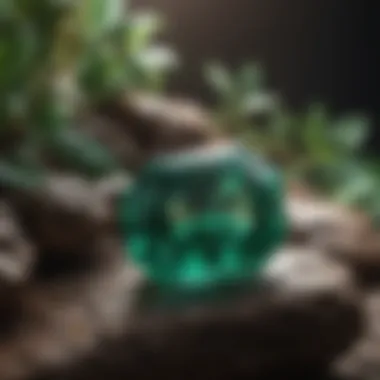

"Emeralds don't just reflect light; they reflect the care and love of their owners. Treat them well, and they'll shine for generations."
Value Appraisal
Understanding the value of natural emeralds is pivotal for collectors and enthusiasts alike. Their worth is not simply determined by the price tag, but rather a complex interplay of various factors. In this section, we will delve into the crucial elements that influence the appraisal of emeralds, guiding readers on what to consider when assessing their gems.
Factors Affecting Value
Market Trends
Market trends play a critical role in shaping the value of natural emeralds. As any savvy collector would know, staying informed about these trends is key to making sound investment decisions. Currently, the demand for high-quality emeralds is on the rise, particularly as they become more sought after in both jewelry and investment circles.
- Key Characteristic: One distinct trait of market trends regarding emeralds is their cyclical nature. Collectors might notice sharper price fluctuations during certain periods, often linked to global economic conditions, fashion trends, or even popular culture influences. Keeping an eagle eye on these shifts enables buyers and collectors to identify when to buy or sell their stones.
- Unique Feature: Notably, the emergence of eco-conscious retailing has brought a fresh perspective to gemstone markets. Here, sustainable sourcing of emeralds garners attention, making ethically mined stones more desirable. The advantage is clear: not only does it cater to an ethical standpoint, but it also taps into a burgeoning market that values transparency and sustainability.
Unique Features of the Stone
Each natural emerald holds individual characteristics that can greatly impact its overall value. Unique features—such as color intensity, clarity, and origin—are all essential in determining that worth.
- Key Characteristic: Color is perhaps the most significant factor. A stone with rich, vibrant green hues often commands higher prices. Variations in saturation, tone, and hue contribute to a stone's desirability. The deeper the green, the more coveted the emerald, and collectors typically favor stones from specific locales known for their distinctive coloration, like those from Colombia.
- Unique Feature: Another aspect worth mentioning is the presence of inclusions. Natural emeralds typically contain inclusions known as 'jardin,' which are often viewed as distinguishing features rather than flaws. While heavy inclusions can detract from an emerald’s value, certain types can add an aura of authenticity, thus making them unique and hence valuable in their own right.
Getting an Appraisal
Choosing a Certified Appraiser
When it comes to evaluating the worth of an emerald, the choice of appraiser is paramount. Working with a certified appraiser with a solid reputation makes the process much smoother.
- Key Characteristic: A certified appraiser is usually affiliated with recognized institutions and possesses experience and knowledge about gemstones. This expertise ensures that the appraisal will reflect the true value based on current market trends and stone characteristics. Select an appraiser who is not only certified but has specific experience with emeralds to benefit from their keen insights.
- Unique Feature: An interesting aspect of professional appraisers is that they often provide more than just a numerical valuation; they offer a detailed written report that outlines their assessment process. This report is invaluable in future transactions, serving as proof of the stone's provenance and authenticity.
Understanding Appraisal Reports
Once an appraisal is complete, it’s crucial to grasp what the report entails. Familiarity with these documents can be empowering for a collector.
- Key Characteristic: Appraisal reports typically detail factors such as carat weight, measurements, color grading, and any notable inclusions. They serve as a comprehensive account of the emerald's attributes, which is essential for insurance purposes or resale considerations.
- Unique Feature: Understanding how to read these reports allows collectors to spot red flags or discrepancies that might arise during a transaction. A thorough appraisal report includes not only valuation but also a description of the stone’s qualities and any treatments it may have undergone. This knowledge can safeguard you against potential pitfalls in future deals.
"A well-executed appraisal can be the difference between a smart investment and a regrettable acquisition."
In summary, the value appraisal of emeralds must be approached methodically. By understanding market trends, recognizing unique characteristics of the stones, and choosing the right appraiser, collectors can navigate the often murky waters of emerald valuation confidently.
Emeralds in Popular Culture
Emeralds hold a significant place not just in the realm of geology and gemology but also in the fabric of popular culture. Their vibrant green hue has long symbolized wealth, beauty, and rarity, capturing the imagination of artists, filmmakers, and fashion designers. These gems are not merely instruments of adornment; they are woven into the stories and aesthetics that define various cultural narratives. Understanding how emeralds are portrayed and valued in popular culture offers insights into their enduring appeal and the sentiments they evoke.
Film and Television
Emeralds have made notable appearances in film and television, often representing power and allure. Take, for example, the iconic role of the green gem in classic films such as "The Wizard of Oz"—the Emerald City being a place of dreams and unattainable desire. In modern cinema, movies like "Titanic" feature emeralds as elements of intrigue and wealth, often serving as plot devices that captivate audiences.
The allure of emeralds is also tied to their historical significance. In many narratives, they serve to emphasize themes of conflict, inheritance, and luxury. Their rich color often embodies the characters' desires or internal struggles. As such, film and television utilize emeralds not merely as jewels but as symbols that deepen character development and enhance storytelling.
"Emeralds, in their lush green glory, have a way of making the ordinary feel extraordinary."
Fashion and Jewelry Trends
In the fashion world, emeralds maintain a timeless relevance. Renowned designers frequently incorporate these gemstones into their collections, recognizing their striking capacity to elevate an outfit. Whether it's a statement necklace adorned by A-list celebrities or subtle accents on haute couture dresses, emeralds are a go-to choice. Their ability to pair seamlessly with various colors, particularly against contrasting hues, makes them particularly coveted during fashion weeks around the globe.
Emeralds are also influential in shaping trends within the jewelry industry. The rise of vintage-inspired pieces has seen a resurgence of emeralds set in intricate designs that harken back to eras when they were first prized. Jewels like earrings or rings set with emeralds are not just accessories; they are considered investments that can appreciate in value. Both emerging and established jewelers recognize this trend, often creating pieces that appeal to collectors and fashion enthusiasts alike.
In summary, the portrayal of emeralds in film and fashion reveals much about cultural values and aesthetics. Their recurring presence in popular culture not only reinforces their desirability but also showcases their role as symbols of beauty, intrigue, and luxury, thereby solidifying their status in the collective consciousness.
The Future of Emerald Collecting
As we look ahead, the realm of emerald collecting is poised for transformation driven by consumer awareness and evolving market trends. Collectors today are increasingly discerning, placing significant emphasis on ethical sourcing, quality over quantity, and the stories behind every stone they acquire. This shift isn't merely a trend; it signifies a profound change in the mindset of both collectors and dealers alike. The rise in appreciation for natural emeralds, paired with a heightened interest in sustainable practices, fundamentally alters how gems are valued and understood.
Emerging Trends in Collectibles
One notable trend is the increasing popularity of vintage and estate emerald jewelry. With the world ever so rapidly embracing originality, collectors are on the hunt for unique pieces that embody history and craftsmanship rather than just focusing on new items. These vintage emeralds often carry stories that connect them to past eras, adding a layer of cultural richness that modern stones lack.
"Collecting is not about what you have, but the stories you own."
Alongside this, the rise of online platforms, including well-established marketplaces and social media groups, opens doors for a global audience, fostering connections between collectors and sellers. Platforms such as Facebook and Reddit have become treasure troves for knowledge sharing and trading, creating vibrant communities where people exchange insights, tips, and, of course, stunning emeralds.
Additionally, a notable interest in miniature collectibles—such as raw emerald specimens—has surfaced. Collectors are now appreciating stones in their natural form, arguably the most authentic state of emeralds. This interest speaks to a broader appreciation for geology and a desire to forge connections with the Earth at a more fundamental level.
Sustainable Practices in the Gemstone Industry
Shifts towards sustainability are not just buzzwords in the emerald collecting community; they are necessities of modern consumerism. Collectors are becoming more conscientious about the origins of their gems. Sustainable practices are gaining traction as both collectors and retailers seek to ensure that emeralds are mined ethically and with minimal environmental impact.
Several organizations are working to promote responsible mining practices, emphasizing fair wages and safe working conditions for miners. Additionally, some companies are investing in reclamation projects that aim to restore the environment in areas previously impacted by mining. This responsible approach adds intrinsic value to the stones since consumers can purchase with a conscience, knowing their gems contribute to sustainability efforts.
Moreover, the demand for lab-grown gemstones is becoming more prominent, particularly among environmentally aware buyers who may not differentiate much between synthetic and natural emeralds when it comes to sustainability. While this could pose a challenge to traditional collecting, it also opens up dialogues about the definition of value in gemstones. Traditionally sourced natural stones can co-exist alongside their lab-grown counterparts, appealing to a broader audience and potentially driving more innovations in mining and gem craftsmanship.
The future of emerald collecting undeniably hinges on adaptability and the willingness to navigate new landscapes—both figuratively and literally. The synergy between traditional appreciation and modern consumer responsibility hints at a promising and rich future for emerald enthusiasts.















